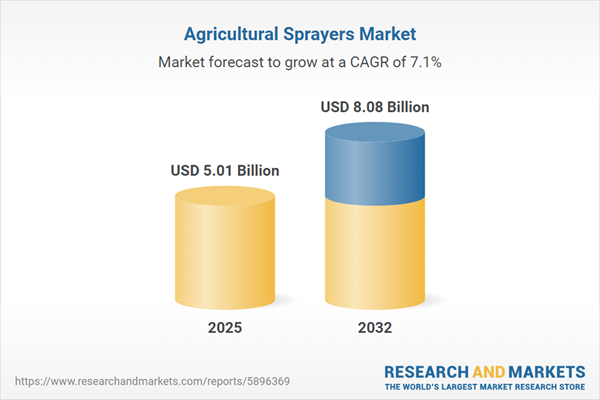Speak directly to the analyst to clarify any post sales queries you may have.
The agricultural sprayers market is experiencing rapid evolution as regulatory demands, technological innovation, and sustainability priorities transform agricultural operations globally. Senior leaders are reassessing opportunities to integrate compliance-driven and efficiency-focused spraying solutions within their organizational strategies to enhance market resilience.
Market Snapshot: Agricultural Sprayers Market Growth and Outlook
In 2024, the agricultural sprayers market was estimated at USD 4.67 billion, with projections indicating expansion to USD 8.08 billion by 2032. This growth is being propelled by the growing adoption of advanced crop management methods and the ongoing shift toward sustainable agricultural practices. The sector is benefiting from next-generation sprayer systems that combine high operational efficiency with digital integration, supporting large-scale environmental responsibility. Industry leaders are modernizing their processes by implementing regulation-compliant spraying equipment, ensuring alignment with prevailing trends in sustainability and resource stewardship.
Scope & Segmentation: Comprehensive Solutions Across Global Agriculture
- Propulsion Methods: Choices span manual, battery-powered, mounted, self-propelled, and trailed sprayers, enabling agricultural operations to match propulsion with specific field conditions, workforce capacity, and available infrastructure.
- Sprayer Types: Models include airblast, boom, handheld, and mist sprayers, each designed for precise targeting or broad-acre coverage and supporting seamless integration with digital field management tools for enhanced oversight.
- Application Areas: Utilization extends to open-field settings, greenhouses, and specialty crop production, providing operational flexibility from traditional to controlled-climate agriculture and supporting optimal resource use under varying conditions.
- Capacity Range: Options under 2,000 liters accommodate small and niche applications, while higher-capacity systems increase productivity for large-scale and high-demand cultivation environments, especially vital during intensive periods.
- Regional Focus: Adoption varies significantly across the Americas, Europe, Middle East and Africa, and Asia-Pacific. This diversity results from distinct regulatory landscapes, technology adoption rates, and region-specific climate pressures, prompting the need for tailored solutions and localized product strategies.
- Competitive Landscape: Prominent players such as Deere & Company, CNH Industrial N.V., AGCO Corporation, Kubota Corporation, Amazone GmbH & Co. KG, KUHN S.A., Hardi International A/S, Horsch Maschinen GmbH, Berthoud SAS, and Tecnoma SAS are raising industry benchmarks by delivering compliant products and service offerings that address performance, safety, and evolving regulatory expectations.
Agricultural Sprayers Market: Key Takeaways for Strategic Leadership
- Integrating sensor-enabled and digital monitoring technologies allows managers to optimize field operations, improving real-time decision-making and advancing longer-term planning for enhanced operational efficiency.
- Transitioning toward battery-powered and electric spraying options is reinforcing environmental stewardship, simplifying compliance processes, and enabling responsible procurement in response to regulatory shifts worldwide.
- Innovations in nozzle technologies and spraying techniques enhance safety in agrochemical application, increase traceability, and promote efficient input utilization, meeting both productivity and compliance targets.
- By adopting modular equipment designs and service-focused procurement models, organizations can streamline scalability, ease fleet upgrades, and reduce ongoing maintenance complexity and associated expenses.
- Customization options and adaptable product offerings assist companies in managing variable regulatory and climatic demands, supporting reliable uptime and maintaining consistent performance as standards evolve.
Tariff Impact: Adapting to Shifting Supply Chains
With 2025 tariff adjustments increasing costs for essential components such as pumps and electronic controls, market participants are updating sourcing strategies by diversifying suppliers, emphasizing local assembly, and pursuing regional alliances. This proactive approach helps stabilize input pricing and maintains continuous access to core elements, strengthening end-to-end supply chain reliability.
Methodology & Data Sources
This research integrates expertise derived from interviews with industry executives and technical specialists, comprehensive on-site audits, and in-depth supply chain assessments. Benchmarking against compliance metrics and sector studies ensures relevant, actionable insights for senior leadership focused on robust strategic decision-making.
Why This Report Matters: Strategic Outcomes for Decision-Makers
- Supports seamless integration of cutting-edge agricultural sprayers technology to strengthen compliance and improve operational agility in an evolving global market context.
- Facilitates close collaboration between compliance, procurement, and technology management, aligning organizational objectives and reinforcing resilience through optimized business continuity planning.
- Delivers a structured approach to encouraging innovation, managing risks, and ensuring effective navigation of the challenges presented by shifting market standards and competitive dynamics.
Conclusion
Targeted investment in advanced technology, coupled with a proactive compliance approach, is essential for sustained success in the agricultural sprayers sector. Strategic planning will underpin continued resilience and operational excellence through ongoing industry transformation.
Additional Product Information:
- Purchase of this report includes 1 year online access with quarterly updates.
- This report can be updated on request. Please contact our Customer Experience team using the Ask a Question widget on our website.
Table of Contents
3. Executive Summary
4. Market Overview
7. Cumulative Impact of Artificial Intelligence 2025
Companies Mentioned
The companies profiled in this Agricultural Sprayers market report include:- Deere & Company
- CNH Industrial N.V.
- AGCO Corporation
- Kubota Corporation
- Amazone GmbH & Co. KG
- KUHN S.A.
- Hardi International A/S
- Horsch Maschinen GmbH
- Berthoud SAS
- Tecnoma SAS
Table Information
| Report Attribute | Details |
|---|---|
| No. of Pages | 191 |
| Published | November 2025 |
| Forecast Period | 2025 - 2032 |
| Estimated Market Value ( USD | $ 5.01 Billion |
| Forecasted Market Value ( USD | $ 8.08 Billion |
| Compound Annual Growth Rate | 7.0% |
| Regions Covered | Global |
| No. of Companies Mentioned | 11 |









